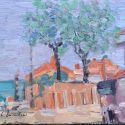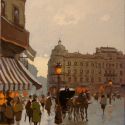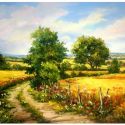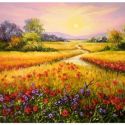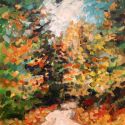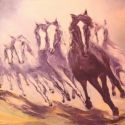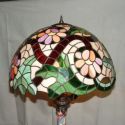Born on 20 September 1855: George de Forest Brush, US painter who died on 24 April 1941.
Although some may think of US painting about 1900 as dominated by Impressionism, this was actually one of the most diverse periods in the history of US art. Realists like Winslow Homer and Thomas Eakins, visionaries like Albert Pinkham Ryder, and a wide variety of still-life and landscape painters all reached the height of their powers at the same time as John Singer Sargent, Mary Cassatt, and the members of The Ten. As US painters matured, so too did US sculptors and architects: Augustus Saint Gaudens, Stanford White, and Louis Sullivan appeared in the same generation, as did Walt Whitman, William Dean Howells, and Henry Adams, giving fresh impetus to US letters. It was thus with reason that, in the decades between the nation's Centennial and 1900, the cultural leaders of the age thought of themselves as participating in an artistic revitalization, as belonging to a US Renaissance.
Within this creative ferment there were some painters who inclined towards a more literal emulation of Italian Renaissance art, as that art was filtered through the academic teaching and example of their mentors at the École des Beaux-Arts in Paris. Among the many young Americans who deliberately sought such instruction was George de Forest Brush, the son of a successful Connecticut businessman. Brush first encountered the systematic artistic professionalism of the French Academy through his teacher at the National Academy of Design, Lemuel Wilmarth. In 1874, Brush went to Paris and placed himself under the tutelage of Jean-Léon Gérôme (1824~1904), one of France's most illustrious art teachers, who demanded the close study of the human form and instilled a spirit of romance in his students through his preference for exotic subjects drawn both from the classical past and from the contemporary Near East. After completing his studies and returning to the United States in 1880, Brush began to paint his own exotic romances as he saw them embodied in the anatomical perfection and noble ideals of the Amerindian.
By the late 1880s, Brush began to move away from the Amerindian subjects that had first won him fame towards elegantly composed and painted images of mothers and children, based on the madonnas of the High Renaissance. His wife Mittie and his blond haired brood of one son and six daughters served as his models. In 1898 Brush embarked on the first of a long series of visits to Florence.
From the time of his first Italian visit, Brush had made a study of Renaissance painting techniques, grinding his own pigments and applying them to carefully prepared gesso grounds to recreate the luxuriant colors of sixteenth and seventeenth century Italian painting. As much as it is a portrait of a disarming young lady, Thea is also an essay in those colors, one whose principal intent is to evoke its Old Master prototypes.
inchide 
Newsletter
Stay tuned with arts. Subscribe to Artline art news send directly to your mailbox by artLine.ro



